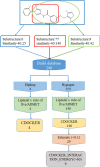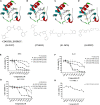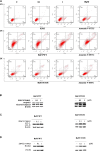The Discovery of Novel BCR-ABL Tyrosine Kinase Inhibitors Using a Pharmacophore Modeling and Virtual Screening Approach
- PMID: 33748144
- PMCID: PMC7969810
- DOI: 10.3389/fcell.2021.649434
The Discovery of Novel BCR-ABL Tyrosine Kinase Inhibitors Using a Pharmacophore Modeling and Virtual Screening Approach
Abstract
Chronic myelogenous leukemia (CML) typically results from a reciprocal translocation between chromosomes 9 and 22 to produce the bcr-abl oncogene that when translated, yields the p210 BCR-ABL protein in more than 90% of all CML patients. This protein has constitutive tyrosine kinase activity that activates numerous downstream pathways that ultimately produces uncontrolled myeloid proliferation. Although the use of the BCR-ABL tyrosine kinase inhibitors (TKIs), such as imatinib, nilotinib, dasatinib, bosutinib, and ponatinib have increased the overall survival of CML patients, their use is limited by drug resistance and severe adverse effects. Therefore, there is the need to develop novel compounds that can overcome these problems that limit the use of these drugs. Therefore, in this study, we sought to find novel compounds using Hypogen and Hiphip pharmacophore models based on the structures of clinically approved BCR-ABL TKIs. We also used optimal pharmacophore models such as three-dimensional queries to screen the ZINC database to search for potential BCR-ABL inhibitors. The hit compounds were further screened using Lipinski's rule of five, ADMET and molecular docking, and the efficacy of the hit compounds was evaluated. Our in vitro results indicated that compound ZINC21710815 significantly inhibited the proliferation of K562, BaF3/WT, and BaF3/T315I leukemia cells by inducing cell cycle arrest. The compound ZINC21710815 decreased the expression of p-BCR-ABL, STAT5, and Crkl and produced apoptosis and autophagy. Our results suggest that ZINC21710815 may be a potential BCR-ABL inhibitor that should undergo in vivo evaluation.
Keywords: BCR-ABL; CML; ZINC21710815; apoptosis; autophagy; pharmacophore model.
Copyright © 2021 Huang, Wang, Qiang, Zhao, Wu, Ashby, Li and Chen.
Conflict of interest statement
The authors declare that the research was conducted in the absence of any commercial or financial relationships that could be construed as a potential conflict of interest.
Figures











Similar articles
-
MPT0B002, a novel microtubule inhibitor, downregulates T315I mutant Bcr-Abl and induces apoptosis of imatinib-resistant chronic myeloid leukemia cells.Invest New Drugs. 2017 Aug;35(4):427-435. doi: 10.1007/s10637-017-0457-9. Epub 2017 Mar 27. Invest New Drugs. 2017. PMID: 28349229
-
Anthelmintic niclosamide suppresses transcription of BCR-ABL fusion oncogene via disabling Sp1 and induces apoptosis in imatinib-resistant CML cells harboring T315I mutant.Cell Death Dis. 2018 Jan 22;9(2):68. doi: 10.1038/s41419-017-0075-7. Cell Death Dis. 2018. PMID: 29358661 Free PMC article.
-
Cotreatment with vorinostat (suberoylanilide hydroxamic acid) enhances activity of dasatinib (BMS-354825) against imatinib mesylate-sensitive or imatinib mesylate-resistant chronic myelogenous leukemia cells.Clin Cancer Res. 2006 Oct 1;12(19):5869-78. doi: 10.1158/1078-0432.CCR-06-0980. Clin Cancer Res. 2006. PMID: 17020995
-
Characterization of cancer stem cells in chronic myeloid leukaemia.Biochem Soc Trans. 2007 Nov;35(Pt 5):1347-51. doi: 10.1042/BST0351347. Biochem Soc Trans. 2007. PMID: 17956348 Review.
-
Chronic Myeloid Leukemia: Existing Therapeutic Options and Strategies to Overcome Drug Resistance.Mini Rev Med Chem. 2019;19(4):333-345. doi: 10.2174/1389557518666181017124854. Mini Rev Med Chem. 2019. PMID: 30332954 Review.
Cited by
-
PROTAC'ing oncoproteins: targeted protein degradation for cancer therapy.Mol Cancer. 2023 Mar 30;22(1):62. doi: 10.1186/s12943-022-01707-5. Mol Cancer. 2023. PMID: 36991452 Free PMC article. Review.
-
The Coiled Coil and C2 Domains Modulate BCR Localization and BCR-ABL1 Compartmentalization, Transforming Activity and TKI Responsiveness.Int J Mol Sci. 2025 Jul 9;26(14):6591. doi: 10.3390/ijms26146591. Int J Mol Sci. 2025. PMID: 40724843 Free PMC article.
-
An Updated Review on Developing Small Molecule Kinase Inhibitors Using Computer-Aided Drug Design Approaches.Int J Mol Sci. 2023 Sep 11;24(18):13953. doi: 10.3390/ijms241813953. Int J Mol Sci. 2023. PMID: 37762253 Free PMC article. Review.
-
PROTACs: The Future of Leukemia Therapeutics.Front Cell Dev Biol. 2022 Sep 2;10:851087. doi: 10.3389/fcell.2022.851087. eCollection 2022. Front Cell Dev Biol. 2022. PMID: 36120561 Free PMC article. Review.
-
Screening and Activity Evaluation of Novel BCR-ABL/T315I Tyrosine Kinase Inhibitors.Curr Med Chem. 2024;31(20):2872-2894. doi: 10.2174/0929867330666230519105900. Curr Med Chem. 2024. PMID: 37211852
References
LinkOut - more resources
Full Text Sources
Other Literature Sources
Miscellaneous

